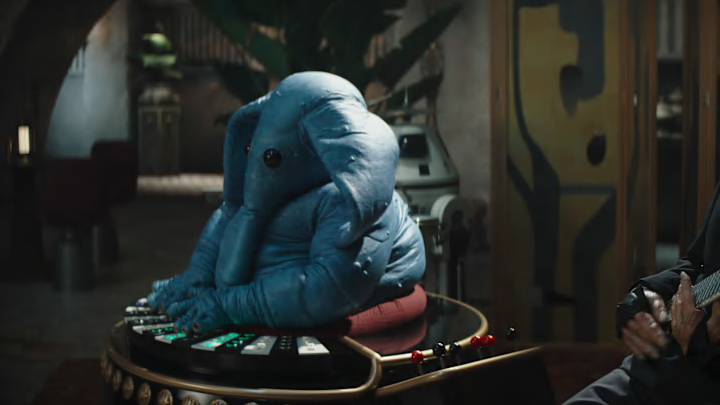Star Wars fan audio dramas began in the southern United States and have existed since 2002. The very first one to get underway started production in 1999, but the first one to reach completion made its debut on the internet on Christmas Day, 2002.
Back in the days of the prequels, one talented writer and Star Wars buff in Atlanta, Georgia, felt stymied by the expense and technical requirements of making a fan film. Five hundred miles to the north, in Richmond, Virginia, the owner of a small (and illegal) radio station knew a member of the local Star Wars fan club (the “Moisture Farm Coop”) and offered to present a Star Wars audio drama on the air if the membership could make one.
Star Wars fan audio was officially in the works. Groups of fans collected in the effort and ran across one another on the forums on TheForce.net. They recruited talent from all over the globe, and, through the magic of the internet, new audio dramas appeared produced by fans.
Of course, drama wasn’t the only format fan audio originally took. Early podcasts centered around Star Wars. Jedi Talk and one with the unlikely name of Digital Llama Radio were the earliest podcasts about Star Wars. Very soon came Chronoradio, produced by Nathan P. Butler, who in 1997 started a hobby keeping film and Star Wars Legends chronology immaculately in line with his Star Wars Timeline Gold.
These podcasts focused on (not surprisingly) Legends chronology, comics, and novels. They also tackled other related topics such as Star Wars games, racism in the Star Wars universe, publishing news, audiobooks of Legends works, and even interviews with editors at LucasBooks. Other franchises of interest to Star Wars fans were also covered.
But fan audio drama? These audio plays were all, and only, about drama.
How was it done?
Every audio production had to start with a script. The second known Star Wars fan audio drama, a project called Rise of Nobility, went through one round of revisions at a writer’s group packed with published authors and a second round of revisions with the Moisture Farmers themselves, devoted fans all. A third round took place once the director took control of the script. Lines were rewritten, characters changed gender, and wild lines were created amidst screams of laughter.
Then again, some writers are just innately talented. Nathan P. Butler can rightly be called the father of Star Wars fan audio. His drama, Second Strike, was the first to finish production, the first to hit the internet, and he made four more audio drama series after that. He also became a bona-fide media tie-in writer, penning his own original novels and the comic “Equals and Opposites,” which Dark Horse Comics published in its Star Wars Tales #21. That story actually has its own pack of action figures from Hasbro. He also got to work on the Star Wars Essential Atlas and published other novellas and short stories for the Decipher’s WARS game and the 10,000 Dawns franchise.
Once scripts were written, fans across the globe became amateur actors and Ben Burtts. Natalie Portman sound-alike Elizabeth Ascot (who acted under a stage name because too many fanboys messaged with offers to pay her to impersonate Portman on their answering machines) constructed a homemade pop filter out of pantyhose and an old embroidery hoop for her starring part as Padme in Rise of Nobility.
Fan sound designers created fearsome monsters from the recorded sounds of their dogs running outside and crunching doggie kibble. Requests were sent out asking for recordings of screams to use for crash scenes. Producers spent hours and hours hunched over WaveLab on their computers, trying to get one Artoo bwoop in the right place.
What sorts of stories are out there to listen to?
Some crews found their options unlimited. Nathan Butler wrote: “Personally, I prefer audio because I can do much of it myself and have greater creative control over the final product. I needn't worry about resources, locations, and such as much. As long as I have internet access, WaveLab, and a cast able to record decent sound files, I can create whatever my imagination desires.” Second Strike is about a group of New Republic fighters taking on a rogue Imperial behind enemy lines.
Other crews found themselves hampered by the voice talent they were able to access. Moisture Farm’s writer wanted to do a dark story about Darth Vader, but while Vader voice talent was available, a Palpatine was not. The Coop had access to semi-professional talent from a local children’s theater group, so good child’s voices were available, as well as a professional actress and director for the director’s chair. They also had a Padme, a Qui-Gon Jinn, and people who could voice Gungans. So, Rise of Nobility is about an air crash emergency Padme lives through as a child that prepares her to become Queen.
The Smuggler’s Run crew, headed by Michael Mays, offers a story of two smugglers who are contacted by a defecting Imperial with the plans for the second Death Star. But an evil bounty hunter stands in the way of getting the plans to the Rebel Alliance. The Logan Chronicles is about a stormtrooper assigned to Tattooine who becomes disillusioned with the Empire after a fearsome attack by Tusken raiders. In the Shadows uses a ton of familiar canon characters. Whatever strikes your fancy, you can probably find in the Star Wars fan audio genre.
Where do I find these shows?
For many years, Nathan Butler’s Star Wars Fanworks website hosted every known fan audio production on the internet. That site closed in 2014, and the new home for Star Wars fan audio is StarkillerSound.com.
Come and visit! Star Wars audio creators everywhere hope to see you there.
